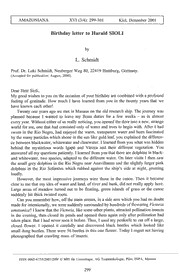
Birthday letter to Harald Sioli PDF
Preview Birthday letter to Harald Sioli
AMAZONIANA XVI (3/4): 299-301 Kiel, Dezember 2001 Birthday letter to Harald SIOLI by L. Schmidt Prof. Dr. Loki Schmidt, Neuberger Weg 80, 22419 Hamburg, Germany (Accepted for publication: August, 2000). Dear Herr Sioli, My good wishes to you on the occasion of your birthday are cornbined with a profound feeling of gratitude. How much I have leamed frotn you in the twenty years that we have known each other! Twenty one years ago we tnet in Manaus on the old research ship. The joumey was planned because I wanted to leave my Bonn duties for a few weeks - as in almost every year. Without either of us really noticing, you opened the door into a new, strange world for me, one that had consisted only of water and trees to begin with. After I had swum in the Rio Negro, had enjoyed the warm, transparent water and been fascinated by the many parlicles which shone in the sun like gold leaf, you explained the differen- ce between blackwater, whitewater and clearwater. I leamed frorn you what was hidden behind the mysterious words Igapó and Yírzea and their different vegetation. You answered all my questions patiently. I learned from you that there are dolphins in black- and whitewater, two species, adapted to the different water. On later visits I then saw the small grey dolphins in the Rio Negro near Anavilhanas and the slightly larger pink dolphins in the Rio Solimões which rubbed against the ship's side at night, grunting loudly. However, the most impressive journeys were those in the canoe. Then it became clear to me that my idea of water and land, of river and bank, did not really apply here. Large areas of meadow fumed out to be floating, green islands of grass or the canoe suddenly hit thick twisted roots. Can you remember how, off the main stream, in a side arm which you had no doubt made for intentionally, we were suddenly surrounded by hundreds of flowering Victoria amazonica? I knew that the Victoria,like some other plants, attracted pollination insects in the evening, then closed its petals and opened them again only after pollination had taken place. But I had never seen it before. Thus, I used my penknife to cut offa large, closed flower. I opened it carefully and discovered black beetles which looked like small dung beetles. There were 56 beetles in this one flower. Today I regret not having photographed that crawling mass of insects. ISSN 0065-6755/2001/2991 @ MPI für Limnologie, AG Tropenökologie, Plön¡ INPA, Manaus 299 I was also amazed about the many bushes which were almost covered by water, but IfI whose leaves appeared green and healthy under water. have understood it correctly, later studies showed that these plants close their stomata firmly under water and reduce their metabolic processes considerably, until the water recedes. I for my part called this .'": r, flood period, the plants' "water sleep". However, the most unusual discovery which I made was the climbing cactus Seleni- ..'iÀ /, ¡ cereus (Strophocactus) witÍii on the tree trunks. You know that I immediately said, "I must have this unusual plant to take it to a botanical garden in Germany." In Bonn it ì t was so well cultivated that it soon formed its wonderful white flowers and could be t thoroughly examined botanically later. For a long time Bonn was the only Botanical ii' Garden in Europe which had this unusual cactus. I also told you, Herr Sioli, that the great painter of the Amazonian plant world, Margaret Mee, was able to complete her painting of Selenicereøs in flower (cf. Figure) using a slide taken in Bonn. If we had never met, maybe that would not have been possible. Many years have gone by since then. We have seen each other nearly every year on your birthday. We have written each other letters and had many long, interesting telephone conversations in which Amazonia played only a small part. The beginning of agriculture in the different regions ofthe earth and the development ofdifferent cultures were the subjects we discussed, but above all the future of mankind and nature. We nearly always finished our talks with your sentence: "We are living in an interesting time". Dear Herr Sioli, may you still have long to observe our times, and, as for me, I wish that I will have many more enjoyable conversations with you. Your Loki Schrnidt Figure: The flowering cactus Selenicereus (Strophocactus) w¡tt¡i (photo by M. TABEL-GERSTER). 300 301
